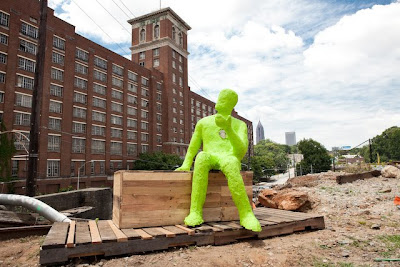
“Art on the BeltLine,” Atlanta’s largest exhibition of temporary art, christens a new public space in the best possible way: with a wide-ranging display of works by a broad swath of Atlanta artists, supported by numerous volunteers and institutions.
The project, which includes performances scheduled throughout its five-month run, was conceived to lure the public to the Beltline (eight miles of it anyway) to discover its pleasures and potential.
To that end, “BeltLine” design director Fred Yalouris opened two very different sections. The East side, urban in character, backs up to old industrial buildings turned into lofts and restaurants and offers great views of the skyline.
The West section, which passes through residential neighborhoods, is densely wooded, in some spots with old-growth pecan trees and tulip poplars or patches of orange day lilies and blue spiderwort. You almost forget you’re in the city.
The project also exposes visitors to the work of 60-plus local artists. The work reflects the varied expertise of its makers — kids, art students, street artists and accomplished pros — and the limitations of time and funds. Most stand on good ideas, but many are rough around the edges.
Dodekapus, an ingenious collective of young artists, made the most of its $100 stipend to build playful tent structures with burlap, bamboo and kudzu. Their makeshift exuberance contrasts with the pristine elegance and meditative tone of Arturo Lindsay’s much bigger-budget structure, “Sanctuary.”
Like these pieces, many works are made to be used. Jeff Mather’s 70-foot-long serpentine picnic table doubles as prop/stage for the Beacon Dance Company. J.D. Koth and David Lougee constructed a domed hut using nearby twigs and branches, a la North Carolina artist Patrick Dougherty. It features an indoor swing and a skyline view.
Sanctuary is a running theme. The Cabbagetown Artists Tribe’s “Pardoned Eden” makes up for its lack of polish with its raucous spirit. It includes junked cars painted to reference dinosaurs (an allusion to the Beltline’s future as a transit corridor), a bevy of birds, some made by Cabbagetown children, and a giant kaleidoscope.
Like the Cabbagetown artists, Jeff Morrison and Staci Stone allude to the Beltline’s transformation. Both turn swords into plowshares, as it were. Morrison constructs his sculpture “Cribbing” with railroad cross ties. Stone planted wildflowers in wooden replicas of tracks for “Even Terrain.”
Katie Hall titled her graceful mosaics on a highway overpass “BeltLine Takes Flight.” For a puckish transformation of Atlanta, see Gregor Turk’s satiric information signs.
Quite a few of the artists made work that responded the Beltline’s history. “The Wanderers,” by the Paper Twins, is one of the show’s stand-outs. A series of painted wood figures evoke the railroad subculture of hobos, loners and other outsiders who might have haunted the area back in the day.
“Art on the BeltLine” is greater than the sum of its parts. The project gives lots of young artists a chance to show their work.
Though hardly a scientific sampling of the art scene, it certainly suggests its vitality. And it shows how broad the term “art” can be. (Lisa Tuttle’s insertion of poems along the trail is a lovely surprise.)
In addition, the show has engaged a broad cross-section of Atlantans. Clients of the Refugee Family Services helped make artwork. Historians did the research for historical markers. Volunteers, including families, spent hours cleaning up the path. And on it goes.
What better way to develop a sense of ownership for the place? Building community should always look, and feel, so good.
